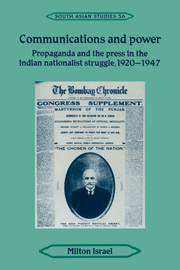Book contents
- Frontmatter
- Dedication
- Epigraph
- Contents
- Acknowledgements
- List of abbreviations
- Note on currency
- Introduction: politics and the press in a colonial setting
- 1 The Government of India: images and messages in the defence of authority
- 2 The news services: ‘impartial Reuters’ or ‘foreign pipes’
- 3 The Congress search for a common voice
- 4 The Bombay Chronicle: a case study
- 5 The struggle overseas
- Conclusion
- Bibliography
- Index
- Miscellaneous Endmatter
1 - The Government of India: images and messages in the defence of authority
Published online by Cambridge University Press: 05 February 2015
- Frontmatter
- Dedication
- Epigraph
- Contents
- Acknowledgements
- List of abbreviations
- Note on currency
- Introduction: politics and the press in a colonial setting
- 1 The Government of India: images and messages in the defence of authority
- 2 The news services: ‘impartial Reuters’ or ‘foreign pipes’
- 3 The Congress search for a common voice
- 4 The Bombay Chronicle: a case study
- 5 The struggle overseas
- Conclusion
- Bibliography
- Index
- Miscellaneous Endmatter
Summary
The statue of John Lawrence which stood near the Lahore High Court at the Mall–Macleod Road crossing was not intended to be there. It had been commissioned in 1880 by friends of the late Governor-General and hero of the Mutiny to stand in London's Waterloo Place as a continuing reminder to future generations of Englishmen of the grandeur and achievements of their imperial heritage. But neither the patrons nor the sculptor liked the completed work when it was set in its place of honour in 1882; and a second statue was duly commissioned, completed, and erected on the same spot in 1884. The discarded original was stored away until 1887, when the sculptor, Sir Edgar Boehm, offered it to the city of Lahore. For all concerned, it seemed no less appropriate that Punjabis too, in generations to come, would pass by and remember.
Over time when the memory of John Lawrence was recalled it seemed sufficiently respectful to satisfy those who had paid twice for his effigy; and in any case, the statue itself became familiar enough to Lahoris to be ignored by all but the most ardent anglophile or antiquarian. In 1920, however, Lawrence's statue, if not Lawrence himself, became the centre of a new confrontation between Britain and India. After years of inattention, someone took another look at its heroic bearing, its steady determined gaze, and in particular at the inscription carved into its pedestal, and was offended. This eight-and-a-half foot bronze giant held a sword in one hand and a pen in the other, and declaimed from its base: ‘Will you be governed by the pen or the sword?’
- Type
- Chapter
- Information
- Communications and PowerPropaganda and the Press in the Indian National Struggle, 1920–1947, pp. 26 - 98Publisher: Cambridge University PressPrint publication year: 1994

